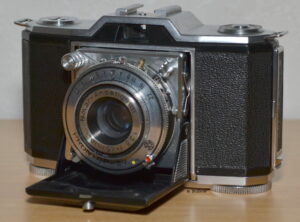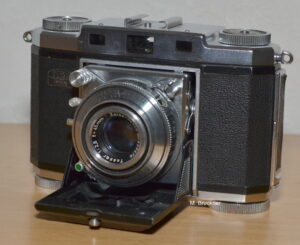Folding Cameras
My first Zeiss Ikon camera was the Ikonta 35. Purchased at the flea market for less than 2.50 euros, this device became the trigger for my current camera collection. I was impressed by the simple design with the beveled corners. All the more so that this design at Zeiss-Ikon continued almost seamlessly into the 1970s.

The Ikonta 35 is a simple but impressively high-quality camera. It was developed in 1948 as the first new design for Zeiss Ikon after the war. The camera initially appears small and handy. When using it, however, you quickly notice that the controls are not laid out as usual. The forward and rewind buttons and the film counter are on the underside, while the tripod thread is on the top of the camera. Since the lens folds out downwards, settings are probably difficult to make when shooting from a tripod. (With the later types Contina and Contessa, Zeiss Ikon solved the problem by inserting the tripod thread in the front flap) There were the Ikonta with different lenses and types of shutters. My little camera has a Zeiss Novar-Anastigmat 45mm f/3.5 lens in a Prontor SV shutter. You can actually get by with a 100 ASA (21 DIN) film in any weather. Flashing is also no problem thanks to full synchronization, since an electric flash can be used at any shutter speed.

Closely related to the Ikonta 35 is the Contina II shown here. (With Zeiss Ikon the model designations are sometimes a bit confusing)
This model offers a built-in (but not coupled) rangefinder, the Zeiss-Tessar lens with a speed of 1: 2.8 and the fast Compur-Rapid shutter (1/500 sec) for the ambitious amateur photographer.
A big advantage with fully mechanical devices: if you treat them with care, only a few things can break. From time to time a drop of oil on the escapement in the slide, a touch of grease on the springs and always keep dry.

However, the luxury model of the Zeiss Ikon folding camera models was the Contessa 35, which gave a touch of „Contax feeling“.
This camera, which is small even by today’s standards, contained everything that was good and expensive at the time. A coupled rotating wedge range finder and an exposure meter ensure flawlessly sharp images in all situations. The world famous Zeiss-Tessar lens was another key selling point. When it was launched in 1950, this camera already cost DM 400. A skilled worker brought home about half of this amount every month. The Contessa did not become a hit, it was simply too expensive and was discontinued in 1955 along with the other folding cameras. The trend was clearly towards compact, easy-to-use and, above all, inexpensive viewfinder cameras.

Other manufacturers also had beautiful and high-quality cameras in their range: Here, for example, the Kodak Retina IIc, which has an interchangeable set of lenses as a special feature. Similar to the Zeiss Ikon Contaflex and the Kodak Retina Reflex, the front lens unit is exchanged for a suitable telephoto or wide-angle element. With a viewfinder camera, however, this requires a suitable attachable viewfinder and a little patience when focusing, since the distances determined have to be transferred to a separate scale.  The standard lens of the Retina IIc is an excellent 6-lens xenon from Schneider-Kreuznach with a light intensity of 2.8. In terms of brilliance and sharpness of the pictures taken, it is even superior to the expensive Zeiss Tessars.
The standard lens of the Retina IIc is an excellent 6-lens xenon from Schneider-Kreuznach with a light intensity of 2.8. In terms of brilliance and sharpness of the pictures taken, it is even superior to the expensive Zeiss Tessars.

In the picture on the left is one of the strangest constructions in German camera construction: the Voigtlander Vitessa. The first Vitessas were built around 1950. The models were changed a few times before they were launched on the market. At the end of February 1953, the Vitessa was shown to the German public for the first time at the special show for industrial products of the right shape at the Hanover Fair. In the months that followed, she quickly scooped up a number of prizes for good industrial form and design. This and the associated exhibitions provided a welcome additional publicity. My model here is one of the last folding Vitessas that were built until about 1956.
From an advertising text at the time: “Pressing the shutter release button with your right index finger puts the Vitessa in readiness for exposure. At the same time, the „combi button“ becomes visible, which disappears completely into the housing when the camera is closed. It is operated with the left index finger and transports the film, cocks the shutter and advances the counter. This is located behind the small window under the rangefinder lookout, along with a handy film type indicator. The film pressure plate is automatically lifted for film transport. This ensures easy transport and protects the film. The range finder is operated with the right thumb on a handy knurled focusing screen on the back of the camera. The depth-of-field clock, which is sunk into the matt chrome-plated headstock, is set simultaneously through them. The precision range finder is identical to the viewfinder and has fully automatic parallax compensation for close-up shots. The outstanding mechanical equipment of the Vitessa models is completely worthy of the optical one. The model for 225 marks has the world-famous, color-corrected Color-Skopar 1:3.5 installed; in the top model of the Vitessa, however, the ultra-fast, six-lens Ultron 1:2.0, a master lens of the famous Voigtländer high-performance anastigmat. Both lenses are coated and impress with their outstandingly lifelike reproduction in black and white and color shots.”
The Vitessa still impresses today with its unusual design, the lightning-fast film transport and the precise, coupled rangefinder.

The little sister of the Vitessa was the Voigtländer Vito IIa in the early 1950s.
The quality of the camera is nowhere near that of the Vitessa, Retina or Contessa. This is not due to the very good Voigtländer optics, but rather the entire construction is a bit weak, so that the lens attachment becomes more and more shaky over the years.
Similar to the Zeiss Ikon folding cameras, the shutter has to be cocked with a separate lever on the lens. The film is transported via an easily accessible quick-release lever on the back of the camera. Despite its small flaws, the Vito is an asset to any collection simply because of its good looks.
Go to viewfinder cameras or home page
